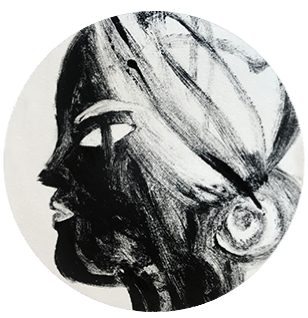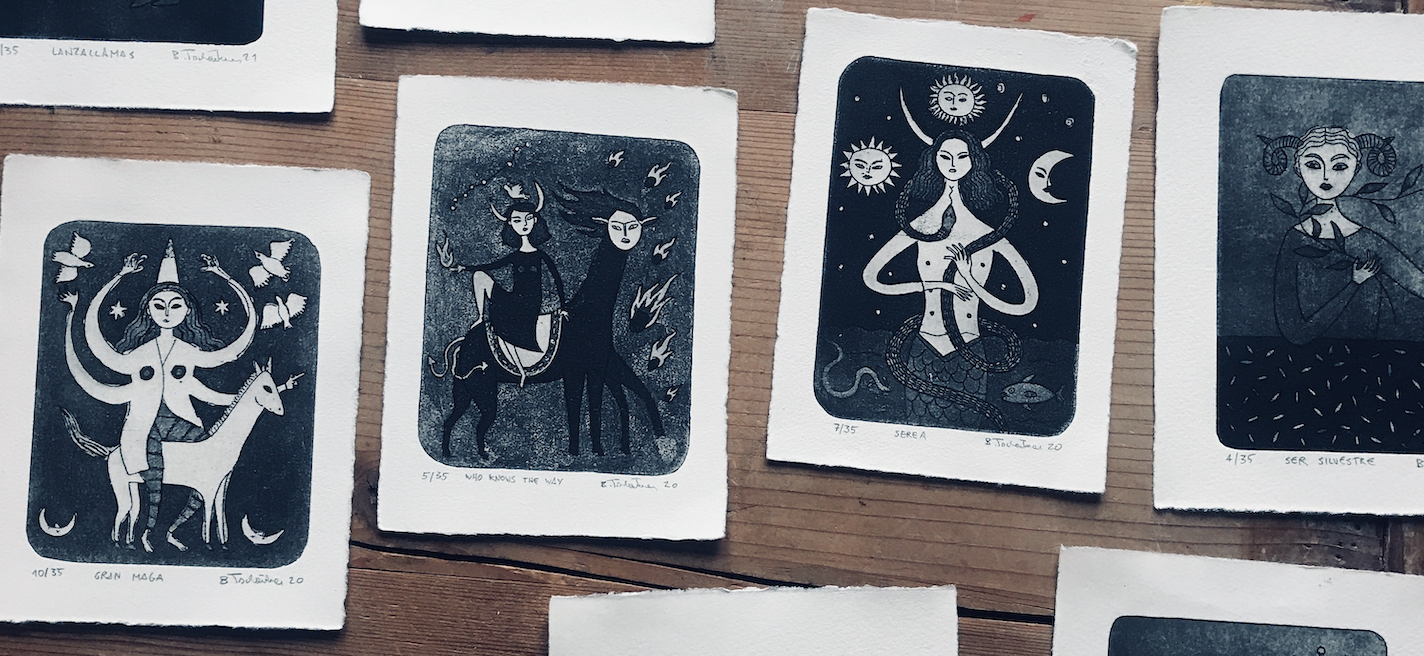I almost never make preliminary sketches, especially not with line drawings. I really enjoy drawing freely and intuitively, and for me, the raw quality of directness has more value than perfection.
That said, I make a lot of "mistakes" when I draw.
In this drawing, if you look closely, you can see that there is another "mistaken" drawing underneath. You can recognize a face in the area of her right armpit, you can also see some unnecessary lines crossing the wings of the bird in the lower right area – and the only reason why there is so much black in that drawing is that there was a lot to cover up.
What started as a mistake became one of my favorite drawings of that book – I even used it for the cover. Without that mistake, it would have never come into existence.
And as much as I still get irritated when I make a mistake and mess up a drawing, I've also become much more relaxed about mistakes. I don't see them necessarily as something bad.
A mistake rather is something that takes you out of your comfort zone, and it can be a great chance and can lead to interesting things – provided you you don't tear out the page and close the chapter, but use it as a ground to let something else grow out of it. Over the years, that kind of "problem-solving" for me even has become a quite interesting and entertaining aspect of my drawing process – it's almost a bit like a game.
I am convinced that most mistakes can be turned into happy accidents – my work is full of them, and so is my life.
This is a page from my book MEGHALAYA, a sketchbook full of drawings, stories, and poems, made while staying with the Khasi tribe in Meghalaya, North East India. The Khasi are matrilineal and matrilocal, which means that all property belongs to women, and a family inherits the mother’s name.
Circular time. A tale from the country of dust and magic
In India, particularly in Rajasthan, the country of dust and magic, you find many miniature paintings of hands and feet with objects painted on them. Sometimes they even have faces. They inspired me for this illustration for a book about yoga ("Was ist Yoga") with Kirstin Breitenfellner.
The most beautiful of these magical hands and feet I found in Udaipur, where I lived some time three years ago, and where I wrote this story – It’s the first part of a text about a magical night in the old town.
CIRCULAR TIME
There were times when I could not tell apart the homes of gods from the homes of humans.
I often went by bike to the artist supply store on the other side of the city, taking the way right through the marvellous old town. I always took a different rout, getting lost in the labyrinth of streets: time was endless back then. One evening, I was cycling back home, when all of a sudden, between houses of the color of sand and clay, there was this bright blue, almost glowing house. I had to stop to look at it. With its big, glowing blue facade it looked so foreign, so different from all other houses that I was sure such an enchanting house must have been built for some deity:
Garlands of last season‘s dried up marigold hang from the painted gate, on which you see paintings of princes riding on elephants and horses. To the right and the left of the gate, in such perfect symmetry as if they were part of the architecture, there are two sand colored street dogs, as if they were guarding the entrance in their sleep.
As I stand there, the house owner appears from somewhere, and he is as curious about me as I am about the house.
I learn it is not a god’s house. But it is a private temple, like all Indian houses – a place where humans and gods coexist. I tell him how fascinated I am with his beautiful house, and he invites me in for some chai in the courtyard, which is just as blue and glowing as the facade.
The color of that glowing house, some kind of electric baby blue, contrasts satisfyingly (like lemon and sugar maybe), with the creamy rose-colored sari of the woman who all of a sudden appears in the atrium with two cups of chai, and who is introduced to me as “aunty” – a shy, sinewy woman with dark skin and bright eyes who does not speak English.
Prem, my host, is a chubby man, friendly and talkative, happy in his magic magic world full of little miracles and self-fulfilling prophecies: an unmysterious man surrounded by mystery, all answer surrounded by questions.
While we are sitting in the doorway sipping chai, he explains me all the magical details of his house, mysterious emblems whose sense he reveals to me with the pride of a real magician (while aunty frequently nods in agreement), including aunty’s many toe rings, which, she explains, he translates, indicate her status of a married woman.
And this sign here for example, half Sanskrit, half Chinese, is to repel the evil eyes that fly around in this city like black butterflies. The painting of the elephant carrying a Maharaja means good luck, while the horse on the opposite door is a symbol of power. The marigolds are a leftover from Diwali, the festival of lights, the larder is not only a food storage room, but also serving as a shrine, a chamber of rice and magic, where the paraphernalia of Ganesh, the elephant god (every household has a different god), are stored. Widows mean bad luck, he tells me, if you meet one on the street, turn around and go back home before you get on your way again. That’s why they dress in white, so you recognise them. The same applies to the milk man. The white of the widow, the white of the milk, bad luck.
But let’s talk about brides now: The dried lemon and chilli hanging from the door frame are waiting to be touched by the sword of the groom, chosen for his bride by an astrologer who makes sure the birth charts of the two are compatible. A young and shy groom who will come riding on a decorated white horse with a plastic sword to enter the house for the first time to take his bride – like Prem dreams of doing one day, in another house, another time…
The Illustration is available as a Super Fine Art Print here.



